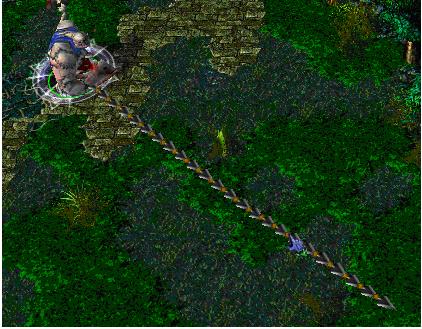HDU 1698(线段树区间更新)
来源:互联网 发布:淘宝盈利模式分析 编辑:程序博客网 时间:2024/04/20 00:51
Just a Hook
Time Limit: 4000/2000 MS (Java/Others) Memory Limit: 32768/32768 K (Java/Others)Total Submission(s): 24705 Accepted Submission(s): 12322

Now Pudge wants to do some operations on the hook.
Let us number the consecutive metallic sticks of the hook from 1 to N. For each operation, Pudge can change the consecutive metallic sticks, numbered from X to Y, into cupreous sticks, silver sticks or golden sticks.
The total value of the hook is calculated as the sum of values of N metallic sticks. More precisely, the value for each kind of stick is calculated as follows:
For each cupreous stick, the value is 1.
For each silver stick, the value is 2.
For each golden stick, the value is 3.
Pudge wants to know the total value of the hook after performing the operations.
You may consider the original hook is made up of cupreous sticks.
For each case, the first line contains an integer N, 1<=N<=100,000, which is the number of the sticks of Pudge’s meat hook and the second line contains an integer Q, 0<=Q<=100,000, which is the number of the operations.
Next Q lines, each line contains three integers X, Y, 1<=X<=Y<=N, Z, 1<=Z<=3, which defines an operation: change the sticks numbered from X to Y into the metal kind Z, where Z=1 represents the cupreous kind, Z=2 represents the silver kind and Z=3 represents the golden kind.
11021 5 25 9 3
Case 1: The total value of the hook is 24.
2008 “Sunline Cup” National Invitational Contest
题意: 给定你1~N的区间,有Q次询问,将x到y的全部变为z。最后输出其总和(最开始默认每个区间的值均为1)
输入:数据组数t,询问次数q,区间长度n。接着有q次询问,分别输入x,y,z。
输出:q次操作后,整个区间的总和。
解法: 线段树的区间更新。
对于线段树的区间修改,当我们找到需要更新的区间后,更新当前区间,而后只记录下更新状态,而不在向下更新。当需要修改更新后区间的成员时,就将记录的更新状态向下更新(注意清除之前更新标记)。
体会:从早上写到中午两点多,当AC时的时候真令人兴奋。虽然对算法都有个大致的了解,但具体写出来的时候各种坑,各种手残~~~~AC万岁
AC 代码:
//#define zhouV
#include<string.h>
#include<stdio.h>
#include<iostream>
#include<algorithm>
using namespace std;
#define LL long long int
#define maxn 1000010
struct ss
{
int l,r,sum,org;
}tr[3*maxn];
void pushup(int id)//向上更新
{
tr[id].sum=tr[id*2].sum+tr[id*2+1].sum;
}
void pushdown(int id)//向下更新
{
int temp=id*2;
if(tr[id].org)
{
tr[temp].org=tr[id].org;
tr[temp+1].org=tr[id].org;
tr[temp].sum=tr[id].org*(tr[temp].r-tr[temp].l+1);
tr[temp+1].sum=tr[id].org*(tr[temp+1].r-tr[temp+1].l+1);
tr[id].org=0;//清楚标记
}
}
void build(int id,int l,int r)//建树
{
tr[id].l=l;
tr[id].r=r;
tr[id].org=0;
if(l==r)
{
tr[id].sum=1;
return;
}
int mid=(l+r)>>1;
int temp=id<<1;
build(temp,l,mid);
build(temp+1,mid+1,r);
pushup(id);
}
void updata(int id,int l,int r,int v)//操作
{
if(l>tr[id].r||r<tr[id].l) return ;
if(tr[id].l>=l&&tr[id].r<=r)
{
tr[id].sum=v*(tr[id].r-tr[id].l+1);
tr[id].org=v;
return;
}
int mid=(tr[id].l+tr[id].r)>>1;
int temp=id<<1;
pushdown(id);
if(mid>=r) updata(temp,l,r,v);
else if(mid<l) updata(temp+1,l,r,v);
else if(mid>=l&&mid<r)
{
updata(temp,l,r,v);
updata(temp+1,l,r,v);
}
pushup(id);
}
int main()
{
#ifdef zhouV
freopen("in.txt","r",stdin);
// freopen("out.txt","w",stdout);
#endif
int t,n,q;
scanf("%d",&t);
for(int j=1;j<=t;j++)
{
int x,y,z;
scanf("%d%d",&n,&q);
build(1,1,n);
while(q--)
{
scanf("%d%d%d",&x,&y,&z);
updata(1,x,y,z);
#ifdef zhouV
printf("%d\n",tr[1].sum);
#endif
}
printf("Case %d: The total value of the hook is %d.\n",j,tr[1].sum);
}
}
测试样例:
1
10
10
4 6 2
1 10 1
1 5 2
1 10 1
1 5 2
5 10 2
1 10 1
1 3 2
3 5 2
3 5 3
OUTPUT:
每一次操作后的值
13
10
15
10
15
20
10
13
15
18
ans:
Case 1: The total value of the hook is 18.
- HDU 1698(线段树区间更新)
- HDU 1698(线段树 区间更新)
- HDU 1698(线段树区间更新)
- HDU 1698(线段树,区间更新)
- HDU 1698 区间更新线段树
- hdu 1698 线段树区间更新
- HDU 1698 【线段树区间更新】
- hdu 1698 线段树 区间更新
- HDU 1698 线段树区间更新模板
- hdu 1698 线段树 区间更新
- hdu 1698(线段树区间更新)
- HDU 1698 <线段树+更新区间>
- HDU 1698 线段树(区间更新
- hdu 3577(线段树区间更新)
- 线段树(区间更新) hdu-1698-Just a Hook
- hdu 1698 Just a Hook(线段树-区间更新)
- HDU 1698 Just a Hook (线段树区间更新)
- HDU 1698 Just a Hook (线段树区间更新)
- okhttp使用总结
- error LNK2019: unresolved external symbol __imp__strnicmp referenced in function _isWithBlack_me@12
- Disruptor源码阅读笔记
- 利用 Python 练习数据挖掘
- Android 的 Runnable 是什么东西?
- HDU 1698(线段树区间更新)
- PNG图像RGBA转索引色
- ThreadPool使用方式说明
- 关于JQuery Validate的那点事
- redis
- struct --结构体
- XamarinForms教程构建XamarinForms开发环境
- 数据结构_8:查找:C++
- Oracle创建表空间和用户


